Learning a new language is both a trend and something of a necessity nowadays. The world is getting smaller. Learning (and eventually speaking) a foreign language helps to break down barriers and connects people on a deeper level of mutual understanding. Furthermore, achieving this mutual understanding will inevitably open a series of doors that will lead to a more interesting and satisfying personal and professional life.
The increasing scope of trends in the travel and tourism industry coupled with the growing demands of online courses is acting as a possible driver for the global online language learning market. You can check out more apps that are currently in demand in the tourism industry.
The ongoing Covid pandemic has only increased the demand for this industry. People bored at home found ample time to learn a new language. The mobile applications allowed users to learn from the comfort of their homes which no doubt contributed to their popularity. This is reflected in the revenue gain too.
In the first UK lockdown in spring 2020 some language learning apps reported a 300% spike in downloads. Share on XThis blog by the Idea Usher experts will explain how to create a language learning app for your target audience.
What is a language learning app?
Language learning apps are software applications that assist you in expanding your vocabulary, developing correct grammar, and becoming fluent in the language you wish to learn. The lessons in these apps assist you in comprehending complex linguistic concepts.

Potential of a foreign language learning mobile application
In 2015, the global digital learning market for the English language exceeded $2 billion, and it is expected to reach $5.13 billion by 2020. According to market reports, the global online language learning market is expected to grow at a CAGR of 13.1% from 2019 to reach $10.5 billion by 2025. Such an app has the potential to become a reliable source of income. This claim is supported by the success story of Duolingo’s creators: in six years, the company received more than $100 million in funding and was valued at $700 million in the final round.

If you look at the above-given infographic, you can see the revenue of the top language learning apps till the first quarter of 2021. These apps are raking in quite a bit of money.
| Language learning app industry details | |
| Market size | $ 21.2 billion |
| Type of learners | Individual learners, Institutional learners |
| Where these apps are popular | North America, Europe, Asia Pacific |
| Top companies (by revenue) | Duolingo, Babbel, Lingokid |
| Languages most in-demand | Mandarin, Spanish, French, Portuguese, Arabic, and Russian |
| Top 5 app features | Chatbots, gamification, live-streaming, mastery quizzes, audio revisions |
| Technologies of app development | AWS, Azure, Java, Swift, Push.io, Twilio, etc (differs for Android and iOS versions). |
| Average monthly downloads (data as per Play Store) | 100K+ |
Top features to make your app more interesting
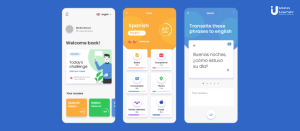
1. Register/login
The app can ask for the user’s email, name, phone number, gender, password, etc. before creating an account. They can sign in the next time with the saved information.
2. User profile
Once the account is created, the users can fill in personal details like age, country of residence, photo, etc. Then it can ask about the language they want to study, the level they want to begin at, set the pace, etc.
3. Learn screen
It is a dashboard to allows users to follow their advancement and includes tools for the learning process itself.
4. Pronunciation checks
This is an essential feature that will help users to pick up the correct pronunciation or accent.
5. Motivational notification
Language learning is a tedious process and users often lose interest midway. A word of encouragement in the middle of learning goes a long way in uplifting their spirit. Timely reminders and push notifications encouraging them is also important.
6. Rewards
Badges and rewards are a fun way for acknowledging users’ learning progress. Rewards are usually given in instances like reaching a course milestone or using the app for a continuous time.
7. Online community
The app should have an open forum where the learners can discuss with each other or interact in the language they are learning. Often the presence of the tutor of the course to answer queries keeps learners on the hook.
8. Shop
Users can purchase different language courses or they can buy rewards through this feature.
9. Live streaming
For a more personalized experience, learners can have a one-on-one interaction with their teachers via video conference. This can motivate them and help boost their morale.
10. Attractive interface
Adding quirky illustrations to the app interface will not only make the visuals more interesting, but it will also make the learning process more fun for the users.
11. User feedback
The best way to keep improving your app is to ask for feedback from your users. The review feature should be available at the end of each course so that you can improve upon it.
12. User history
This will help your user to check for the courses they had learned earlier, go over their progress, achievements, etc.
Advanced features to make your app stand out
1. Chatbots
They can serve as virtual advisors. Depending upon the emotional state of the students which, when identified by the chatbots, can modify the response with language adaptation or even incorporating a joke.
2. One-on-one tutoring
If a user is having difficulty understanding the pre-designed course, they can have the option of joining a virtual personal tutor who can clear their doubts and provide a human touch.
3. Gamification
A newly developed feature, users can learn the language while playing fun games like puzzles. This makes the learning process more fun and productive. It can suit learners of all ages.
4. Competition among users
A competitive spirit always brings out the best in people and serves as a tool for self-motivation. App owners should understand how to leverage this human nature in the app’s and the user’s favor. You can include a dashboard in the app where users can view their performance and compare it to that of some top performers or their friends. This will encourage users to become more involved with the app.
5. Set goal
Another way to encourage the user is to let them fix goals for themselves and reward them for achieving the target.
How to create a language learning application?
The basic steps followed while creating any mobile applications are user & market research followed by visual design & app development terminating with QA & Testing. Then the app is ready to be launched and promoted in the market.
Read on to get a detailed description of how to create a foreign language learning app.
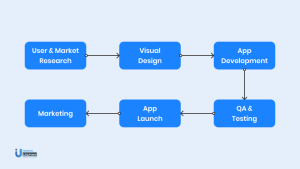
1. Plan the concept of the app
Apps are the perfect way to bring your ideas to life and make some difference in society. But with increasing competition in the ed-tech field, your app needs to have some special features to appeal to the users and gain an advantage over competitors.
Before moving any further, the owner ought to have a transparent plan concerning the aim of the app and the way they might prefer to the app to function. Once the core plan behind developing the app becomes clear, it’s easier to maneuver on to successive steps.
2. Gather the right information
For a language learning app, the right information is the key. Get the help of linguistic experts and design a course that is informative, easy to grasp, and engaging.
3. Create mock-up models
A good user experience is the key to the success of your app unless you want them to leave their course midway, frustrated by User Interface inconsistencies. App mockups are an often overlooked key step in the designing process.
It gives you a genuine idea about the look and feel of the app once it’s ready for the market with the right choice of the design hierarchy, widgets, etc.
4. Hire the right developers
The right set of developers can make the app development process much easier and faster. The development team will take care of a lot of aspects- planning, brainstorming, and implementing the features of the app. An efficient team would write the code of the app, design it for the platform of your choice and ensure it’s smooth running-all with your valuable feedbacks.
A Skilled Developer For Every Project
Trusted by 100+ clients
The right set of developers usually provide post-launch support too.
5. Conjuring an attractive UI/UX design
Learning a language is not an easy task. What can make the process a tad less tedious is if there are great visual features. A clean and strong design language ensures a consistent and seamless user experience. It will make your app easily understandable and motivate users to return.
Developers can use Cascade Style Sheet (CSS) and Bootstrap on the client-side. They can use Python, JavaScript, Ruby, or Django on the server-side. If you are developing for Android, you must use Java, and if you are developing for iOS, you must use S.
6. Create a strong database
Language learning apps come with a lot of data. So it is useful to enable a strong database like MySQL, MongoDB, Cassandra, or any other that you find the best fit to handle large data.
7. AI-enabled chatbox integration
For a more personal experience and customized learning, the developers can integrate an AI-enabled chatbot to increase effective learning. This feature is being used by top players like Duolingo.
8. Real-time analytics
This will help users connect with a virtual tutor. You can use Java frameworks like Spark or any other such as Hadoop, Apache, CISCO, BigData, IBM, and so on.
9. Cloud storage
With a lot of topics on board, there remains the chance of content loss. You can use cloud storage to reserve course content or user information. Both Amazon and Google have very efficient cloud storage services.
10. Technology stack
An efficient team of developers will bring with them an excellent choice of technology stack to build the app. A purposeful tech stack gives you the advantage of developing a scalable and highly functional app that will beat the competition. A list of important tech stacks to consider is given below.
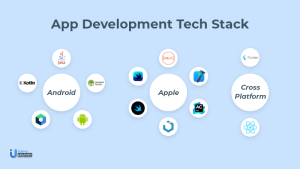
| Cloud Environment | AWS and Google |
| Front-end Development | CSS3 and Bootstrap |
| Back-end Development | Angular JS, Python, or JavaScript |
| Database | Cassandra, Postgres, MongoDB, HBase, MySQL |
| Data Management | Datastax |
| SMS, Voice & Phone Verification | Nexmo, Twilio, Sinch |
| Real-time Analytics | Spark, IBM, Apache Flink, Hadoop, Cisco, BigData |
| Data Storage & Security | Amazon data servers or Google Cloud Storage |
| Payment Methods | Braintree, Stripe, PayPal, & Credit Card |
| Real-time Notifications | APNS |
| Programming | Google Web Toolkit |
| Email marketing Integration | MailChimp, SendinBlue |
11. App testing
This is the most important step. Before launching an app in the market, it is important to have Quality Assurance (QA) testing. This will
- help identify bugs, defects and give you a chance to improve them before launch
- improve user experience by eliminating loopholes
- provides an objective, third-party perspective on the product.
12. App launch
It is always advisable to launch a beta version of the app before the actual app launch. Releasing a beta version will not only generate a buzz among users, but it will also generate feedbacks, give rise to new ideas, etc.
Why are language learning apps creating a buzz?
Learning a foreign language can be an enthralling experience that can transform your life. While learning a new language through an app can be difficult, the benefits far outweigh the difficulties.
1. Learn anytime anywhere
The main advantage of these apps over offline language learning courses is that you can learn these courses from any part of the course at a time convenient to you. The apps can be downloaded to your smartphone/ tablets. Based on the subscription you have, you can download the course and study it offline too.
2. Choose from a wide array of languages
With a click of your phone, you have a number of global languages at your fingertip. The courses are well-designed and with due diligence, you can master any language by sitting at home.
3. Learn at your own pace
Everyone has their own style and pace of learning. There are quick learners and then there are people who need to learn every aspect of a lesson before moving on to the next. In the case of offline classes, learners often fail to keep up with the momentum. This kind of app appeals to all because it lets you learn at your own pace according to your needs and liking. If you need revision you can easily switch back to the previous chapter.
For a more advanced app, you can personalize the course with the help of the user’s previous data.
4. Fun and easy learning
If we are being very honest, learning a new language can become tedious and boring at times. However, the same thing doesn’t hold true for a language learning app. The medium of learning is a smartphone or tablet, one we are never too tired to pick up. Even within the app, the animation, sounds, video, etc make learning an enjoyable experience. It’s easier to visualize and memorize.
When you combine this with the recent trend of learning a language through gamification, the process has never been more amusing and stimulating.
5. Performance-wise analysis and report
The app can keep track of the users’ performance, their pace, the stage they are at, and how much time before they finish. Based on this the app has an automated feature to show detailed reports.
6. Level wise learning
Depending on the users’ fluency in the language, the app can have courses designed at beginner, intermediate and advanced levels.
7. Saves time
If the app manages to pack in reading, writing, and practice all at the same time then it would save the user both time and money. They do not need to switch between different platforms.
8. Apps are affordable
If you try to study a language at an institute, you may find the fee to be a bit expensive. But most of the courses available in the apps are free, freemium or you pay a small fee. Extra fees are only charged to remove ads or if you want a one-to-one interaction with your teacher.
How to monetize language lessons apps?

It is not sufficient to just own or develop an app. You need to find suitable techniques to earn from the app. Depending on the success level of your “app”, there are various ways with which you can generate revenue.
1. In-app advertisement
It is one of the tried and tested ways to monetize your app. Since educational apps are the rage right now, you can associate with ed-tech companies trying to build a brand and promote them on your “app”.
2. Subscription
Another widely prevailing revenue generator is the subscription model. Provide your users with a one-of-a-kind set of features and services. Users can benefit from offline service, ad-free learning, and personalized attention under the subscription model.
3. Freemium model
This is best divided into two parts: the free version of the app and the premium version of the app. Using the freemium model, you give your users access to a portion of your educational app for free.
This could include basic features, orientation level modules, pilot elements, or an MVP version of the app that is free to use. The rest of the advanced education material, learning resources, or a more elaborated version of the educational app will be available for a fee against subscription or convenience fees.
4. Data monetization
If you have users enrolled, you can request their orientation, demographic, and academic information. With the permission of the user, this can then be churned into valuable information and conclusions. You can use this to better serve and earn with data-driven offerings. Alternatively, it could be rented to a research organization for data aggregation and analysis.
5. In-app purchases
Most of these apps allow users to use the majority of the services for free. But you can push them to purchase various value additions or enhanced facilities. Learners can make in-app purchases without leaving the app window. How much does it cost to develop a language learning app?
How much does it cost to develop a language learning app?
A rough estimate of the cost of developing such an app can be determined based on the technologies and features involved, as well as the number of hours spent.
The cost of developing a language learning app can be as high as the number of combined technologies and the country where it is being developed. Nonetheless, an application with useful features can cost between $20,000 and $200,000 for a single platform. If you decide to build for both iOS and Android platforms, the cost could rise to around $40000.
What are the factors affecting the cost of app development?
1. Features of the app
Many developers charge by the hour. If you want to create a complex app with advanced features, it will take more time and cost more money.
2. Advanced features
If you are building an app that has an edge over your competitors, then you need to add some cool user-friendly features. Development cost depends a lot on the complexity of the technology being used.
3. App development platform
This is another feature that determines the cost. If you decide to develop an app for the hybrid platform (for both Android and Apple users) then you need to shed more money. Even for single platform development, there will be a variation of development charges between Android and iOS.
4. Country of development
The cost of app development often changes depending on the location and experience of the companies and developers. If you want an experienced developer who has worked on notable projects in the past, you will have to pay a higher fee. The price is also broken down by region. Developers of first-world companies charge more than developers of developing companies.
5. Size of the development team
If you hire a team with a larger number of members, you must pay more because they charge for each member raises the overall cost. And before hiring anyone for the job you should be aware of the app development team structure composed mainly of developers, designers, and managers.
- Business analysts
- Project manager
- iOS & Android developers
- UI/UX front-end developers
- Back-end developers
- QA professionals
- Sales and marketing professionals
Prominent examples of language learning apps
1. Duolingo
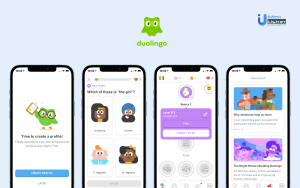
Duolingo is one of the best free language learning apps because it offers a variety of learning activities such as fill-in-the-blanks, multiple-choice questions, and flashcards. Its game-like features also encourage users to earn gems by completing lessons, lose hearts by making mistakes, and earn rewards by going on “streaks” (consecutive days of studying).
On the plus, it is one of the best offline language learning apps.
2. Memrise

Memrise ranks high on the list of free language learning apps because of its diverse learning tools, which include native speaker videos, multiple-choice questions, typing tests, and listening activities. It also provides “classic reviews” and “speed reviews” to test your understanding of previously learned material.
3. Busuu

Busuu users can learn new vocabulary and grammar with linguist-designed lessons that include audio recordings, images, fill-in-the-blank questions, true or false questions, and more. One unique feature allows users to provide feedback on each other’s speeches and writing.
4. Babbel
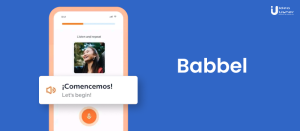
Babbel not only offers a vocabulary for everyday conversations and speech recognition technology to improve pronunciation, but it also provides useful explanations in the users’ original language to help them grasp grammar topics.
5. Hello Talk
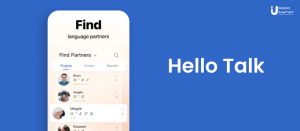
HelloTalk is a language learning app that pairs you with native speakers for language exchange. The app allows users to communicate via texting, voice messages, video chats, and drawing.
6. Mindsnacks

MindSnacks provides the type of snack that is good for the brain. This is due to the fact that it satisfies the language learning hunger with entertaining games.
Each app contains between eight and nine games designed to improve vocabulary and conversation skills. With over 40 hours of content, even the most ardent gamer will be kept busy.
Final words
Foreign language study is no longer a whim of “eternal students.” It is beneficial in broadening business horizons, particularly in the search for new employment opportunities, and contributes significantly to intellectual development. So if you are dwindling on whether to launch an app in this sector, now is the perfect time to hire the right app development company and go for it.
Can Idea Usher help you in creating your language learning app?
Idea Usher has a long history of developing innovative apps. Our vibrant portfolio stands as proof of the hard work that our team of experienced developers put through every day to actualize the dream of our clients.
Our team will work with you throughout the entire kickstarter and pre-order period and support you throughout the entire post-launch journey proving you with any assistance required.
Contact our expert developers today if you want to know how to create your own language learning app and you can avail of our free consultation service.
FAQ
1. Which is the best app to learn a language?
There are numerous language learning apps on the market. Some of the best include Duolingo, Memrise, Busuu, Babbel, Beelinguapp, Mindsnacks, and others.
2. Can a language learner create their own app?
If you have sufficient coding knowledge then it is easy to build a language learning app with basic features. For advanced features, however, it is advisable to approach a reputed developer.
3. How much does a language learning app cost to develop?
The cost of developing a language learning app depends on the number of combined technologies and the country where it is being developed. Nonetheless, an application with useful features can cost between $2,000 and $200,000 for a single platform.



















